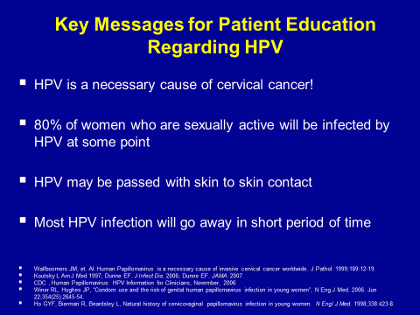Berman - Figure 6 - Patient Education re: HPV Text
Berman - Figure 6 - Patient Education re: HPV
Whether I am screening or talking about anything related to lower genital tract disease, there are key messages that can be presented succinctly and quickly.
- HPV is a necessary cause of cervical cancer. If you do not have HPV you will not develop cancer.
By the same token, if you have a positive test it does not mean you will develop cancer, most people do not, but finding those women who are positive allows us to stratify risk and follow those women diligently who have the potential to develop neoplasia or cancer. - 80% of women who are active sexually will be infected at some point. You saw in the earlier discussion, that most everybody who is active sexually will be infected, and that peak of being HPV infected is the mid 20s. That drops off over time, and that is why when we screen women with an HPV test starting at age 30, if HPV is positive that is when it more likely represents infection that is persistent. We don’t want to find HPV by screening young women under 29 where the majority will test positive at some point.
In a study by Ho and colleagues*, a landmark study, 85% of college women will test HPV positive at some point. But retest those women later, and most of them will turn HPV negative. *Ho GYF, Bierman R, Beardsley L, Natural history of cervicovaginal papillomavirus infection in young women. N Engl J Med. 1998;338:423-8 - HPV may be passed by skin-to-skin contact. The most likely time HPV is transmitted to the cervix is with penetrative intercourse, but we know that with all kinds of creative sexual activity just short of penetration, it is possible for HPV to be passed by skin-to-skin contact.
- Most HPV infection will go away in a short period of time. As I said, by 24 months most infections will have cleared.
